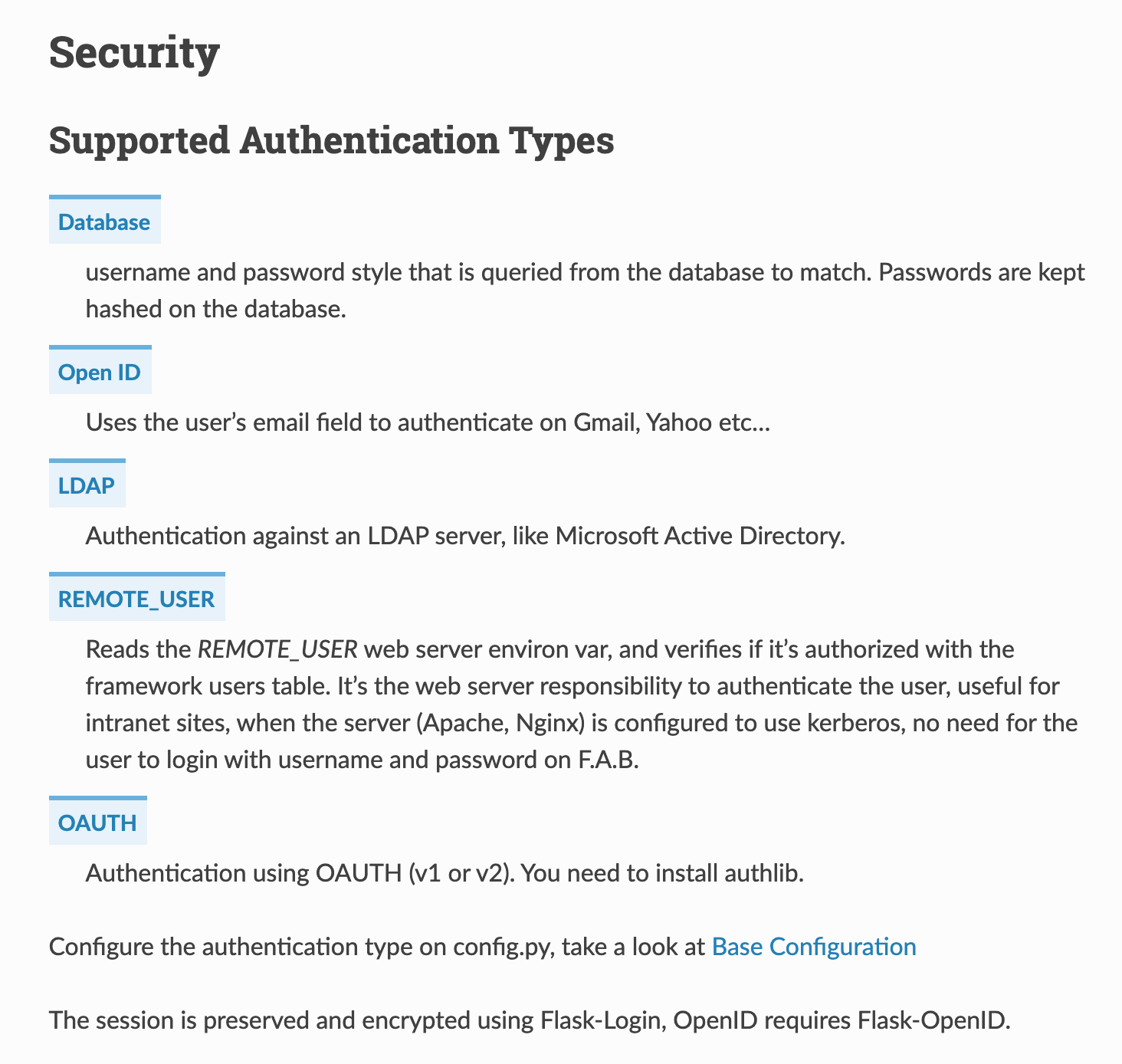为了统一和安全考虑,将superset接入公司账号系统,使用员工现有邮箱和密码作为登录方式
env:superset 0.36.0

Superset使用FAB(Flask-Appbuilder)实现了用户权限功能,登录认证框架。
FAB支持以下几种认证方式:

这里使用的是REMOTE_USER方式,通过调用remote server api,从remote web server获取用户的认证信息,也就是公司的登录系统,认证通过则将用户信息保存到db中,只要验证用户的session没有过期,就可以直接访问网站。授权验证通过后,通过appbuilder.sm.add_user,将用户添加到superset用户库中,后面进行该用户的应用内权限管理。
1.首先是配置
通过阅读superset/config.py中的代码, 如果需要自行修改配置, 创建superset_config.py文件。
在superset 创建自定义配置文件 superset_config.py
添加以下内容,替换默认CUSTOM_SECURITY_MANAGER中使用的SecurityManager. 然后写一个CustomSecurityManager类去继承SecurityManager,
1
2
3
|
from superset.custom_security import CustomSecurityManager
CUSTOM_SECURITY_MANAGER = CustomSecurityManager
|
2.修改登录页
/root/incubator-superset/superset/templates/appbuilder/navbar_right.html
主要是为了修改登录和登出按钮的连接跳转。
修改为以下内容:
将110行注释,替换
将125行注释替换,添加124行
1
2
3
4
5
6
7
8
|
109 <li><a href="{{appbuilder.get_url_for_userinfo}}"><span class="fa fa-fw fa-user"></span>{{_("Profile")}}</a></li>
110 <li><a href="/sso/logout"><span class="fa fa-fw fa-sign-out"></span>{{_("Logout")}}</a></li>
111 <!--<li><a href="{{appbuilder.get_url_for_logout}}"><span class="fa fa-fw fa-sign-out"></span>{{_("Logout")}}</a></li>-->
123 {% else %}
124 <li><a href="/sso/login">
125 <!--<li><a href="{{appbuilder.get_url_for_login}}">-->
126 <i class="fa fa-fw fa-sign-in"></i>SSO_{{_("Login")}}</a></li>
127 {% endif %}
|
3.自定义方法继承SecurityManager
写一个custom_security.py类去继承SecurityManager, 重写一些view自定义登录效果。
在superset目录新建custom_security.py脚本。
- 每次将请求中的ticket,向remote server进行验证,如果有效,直接登录成功,否则重新登录sso进行授权。成功授权后判断用户是否已经出现在superset用户库中,如果没有添加该用户,指定账户名为用户名,密码默认为用户名。
1
2
3
4
5
6
7
8
9
10
11
12
13
14
15
16
17
18
19
20
21
22
23
24
25
26
27
28
29
30
31
32
33
34
35
36
37
38
39
40
41
42
|
from flask import redirect, g, flash, request
from flask_appbuilder.security.views import UserDBModelView,AuthDBView
from superset.security import SupersetSecurityManager
from flask_appbuilder.security.views import expose
from flask_appbuilder.security.manager import BaseSecurityManager
from flask_login import login_user, logout_user
import requests
import superset_config
class CustomAuthDBView(AuthDBView):
@expose('/sso/login/', methods=['GET'])
def sso_login(self):
print("------------ login", request.args)
if request.args.get('ticket') is not None:
r = requests.get(**login_url**, verify=False)
print("------------ validate", r.json()['username'])
username = r.json()['username']
user = self.appbuilder.sm.find_user(username=username)
if user is not None:
print("------------ find user", user)
login_user(user, remember=False)
return redirect(self.appbuilder.get_url_for_index)
else:
user = self.appbuilder.sm.add_user(
username=username,
first_name=username.split('.')[0],
last_name=username.split('.')[1],
password = username,
email=username,
role=self.appbuilder.sm.find_role(self.appbuilder.sm.auth_user_registration_role))
print("------------ new user", user)
login_user(user, remember=False)
return redirect(self.appbuilder.get_url_for_index)
else:
return redirect(***login_url***)
@expose('/sso/logout/', methods=['GET'])
def sso_logout(self):
print("------------ logout", logout_url)
return redirect(**logout_url**)
class CustomSecurityManager(SupersetSecurityManager):
authdbview = CustomAuthDBView
def __init__(self, appbuilder):
super(CustomSecurityManager, self).__init__(appbuilder)
|
刷新superset,查看登录页面右上角登录按钮。
参考 :


